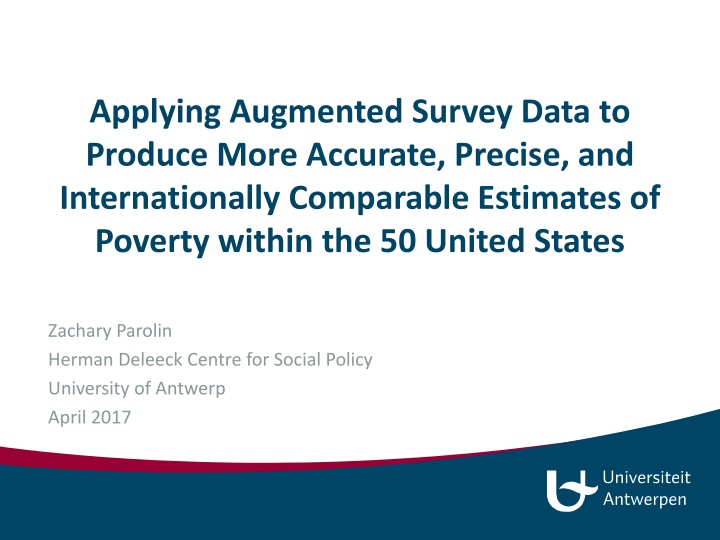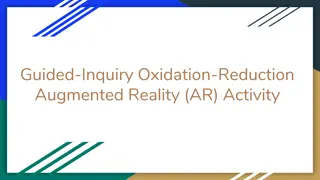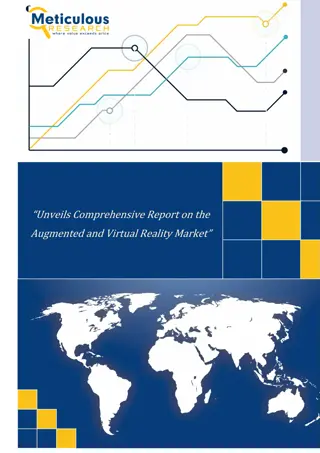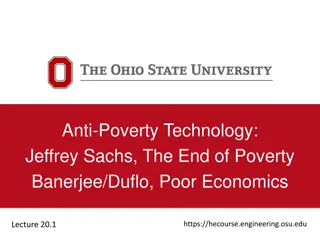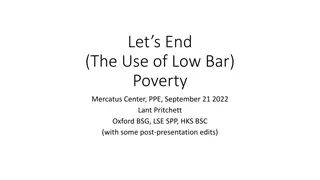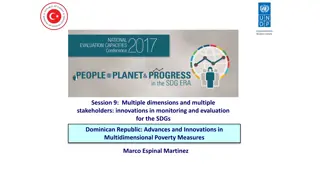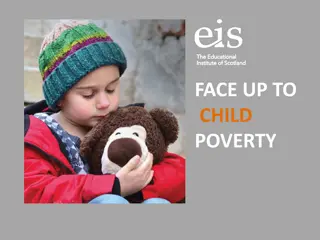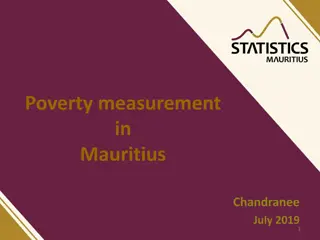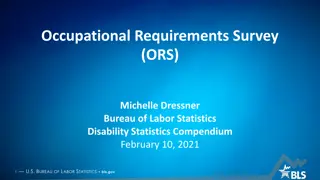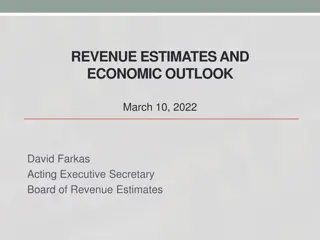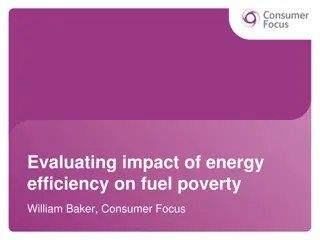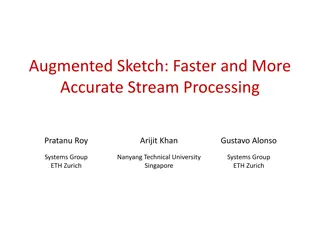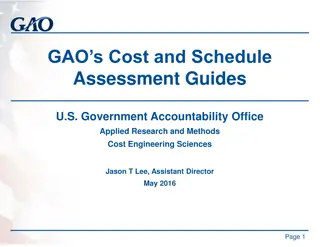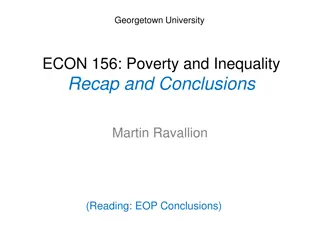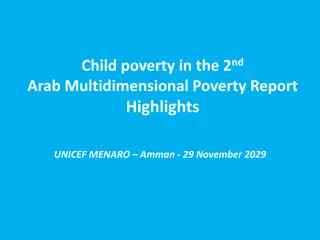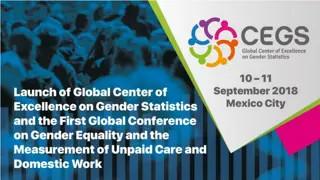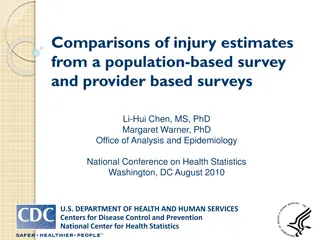Augmented Survey Data for More Accurate Poverty Estimates
how augmented survey data addresses shortcomings in American poverty research, providing precise and internationally comparable estimates. Learn about measurement errors, policy conceptualization, and cross-state variations. Discover solutions like applying augmented CPS microdata for improved reliability at state-level estimates.
Download Presentation

Please find below an Image/Link to download the presentation.
The content on the website is provided AS IS for your information and personal use only. It may not be sold, licensed, or shared on other websites without obtaining consent from the author.If you encounter any issues during the download, it is possible that the publisher has removed the file from their server.
You are allowed to download the files provided on this website for personal or commercial use, subject to the condition that they are used lawfully. All files are the property of their respective owners.
The content on the website is provided AS IS for your information and personal use only. It may not be sold, licensed, or shared on other websites without obtaining consent from the author.
E N D
Presentation Transcript
Applying Augmented Survey Data to Produce More Accurate, Precise, and Internationally Comparable Estimates of Poverty within the 50 United States Zachary Parolin Herman Deleeck Centre for Social Policy University of Antwerp April 2017
Three Shortcomings in American Poverty Research 1. Measurement Error within Current Population Survey (CPS ASEC) 2. Conceptualization of Poverty within U.S. Policy Research 3. Masking of Substantial Cross-State Variation in Poverty Outcomes 2
Resolving These with Two Broader Objectives: 1. To allow for more accurate estimates of American poverty outcomes 2. To advance the practice of comparative social policy research, both within an intra-U.S. and international context 3
Resolving These with Two Broader Objectives: Brady & Destro (2014: 596): The main limitation of American social policy literature is that it concentrates exclusively on the United States . 4
Resolving These with Two Broader Objectives: 1. To allow for more accurate estimates of American poverty outcomes 2. To advance the practice of comparative social policy research, both within an intra-U.S. and international context 5
Shortcoming #1: Measurement Error within CPS (& LIS) Problems with the U.S. Current Population Survey: Underreporting of means-tested benefits Meyer & Mittag (2015): Roughly 60% of TANF, 30% of housing assistance, 40% of SNAP not captured in recent CPS Wheaton (2007): In 2002, about 50% of TANF benefits, 40% of SNAP, and 30% of SSI benefits were likewise absent. Inadequate state sample sizes to produce state-level estimates 6
Solution #1: Applying Augmented CPS Microdata Imputing benefit corrections for four means-tested programs: TANF, SNAP, Housing Subsidies, SSI (via Urban Institute s TRIM3 Simulations) 1. Three-year averages to improve reliability of state- level estimates (via U.S. Census Bureau) 2. 7
Solution #1: Applying Augmented CPS Microdata Urban Institute TRIM3 Imputation Procedure: Appropriate filing unit is identified Eligibility checks are performed taking into account any applicable state- level restriction Income counting toward the means-test is compiled Benefit computation is conducted A participation decision is predicted based on the reported likelihood of the particular person, family, or household actually receiving the benefit (using data on state-specific take-up rates) Full details: Wheaton (2007) and TRIM3 (2012) 8
Comparison of Administrative Data on Total Benefit Levels with Augmented CPS ASEC (2008-2010 average, in $100,000s of 2009 USD) Administrative Data Augmented CPS ASEC Original CPS ASEC SNAP TANF SSI Housing Subsidies Total Benefits Percent Captured Total Benefits* Percent Captured Total Benefits Percent Captured Total Benefits Percent Captured $48,890 100% $9,546 100% $50,520 103.3% $31,383 62.1% $6,119 64% $38,577 84% $8,272 86.7% $45,942 100% $40,920 100% $45,672 99.4% -- -- $30,595 74.8% 9
The effects of correcting for underreporting of means-tested benefits on the family-type income distribution of children in lone-parent and two-parent households (2008-2010, in 2009 USD) 25000 22500 20000 17500 15000 12500 10000 7500 5000 2500 0 5 10 15 20 25 30 35 40 45 50 55 60 65 70 75 Percentile of Income Distribution Augmented CPS, Lone Parent HH Original CPS, Lone Parent HH Augmented CPS, Two-Parent HH Original CPS, Two-Parent HH 10
Estimated annual transfer benefit value & coverage rate across age groups, before and after corrections for underreporting (2008-2010 average, 2009 USD) Original CPS ASEC Data Augmented CPS ASEC Data Absolute Increase Relative Increase SNAP $815 18.9% $308 9.7% $110 5.5% $1320 28.3% $509 15.9% $154 8.4% $505 9.3% $201 6.1% $44 2.9% 62% 49% 65% 63% 40% 52% Mean Benefit Value Coverage Rate Mean Benefit Value Coverage Rate Mean Benefit Value Coverage Rate Children Working- Age Adults Pensioners TANF $182 4.4% $61 1.7% $14 0.4% $270 6.8% $92 2.6% $28 0.8% $87 2.4% $32 0.8% $14 0.3% 48% 55% 52% 49% 100% 80% Mean Benefit Value Coverage Rate Mean Benefit Value Coverage Rate Mean Benefit Value Coverage Rate Children Working- Age Adults Pensioners 11
Estimated annual transfer benefit value & coverage rate across age groups, before and after corrections for underreporting (2008-2010 average, 2009 USD) Original CPS ASEC Data Augmented CPS ASEC Data Absolute Increase Relative Increase SNAP $815 18.9% $308 9.7% $110 5.5% $1320 28.3% $509 15.9% $154 8.4% $505 9.3% $201 6.1% $44 2.9% 62% 49% 65% 63% 40% 52% Mean Benefit Value Coverage Rate Mean Benefit Value Coverage Rate Mean Benefit Value Coverage Rate Children Working- Age Adults Pensioners TANF $182 4.4% $61 1.7% $14 0.4% $270 6.8% $92 2.6% $28 0.8% $87 2.4% $32 0.8% $14 0.3% 48% 55% 52% 49% 100% 80% Mean Benefit Value Coverage Rate Mean Benefit Value Coverage Rate Mean Benefit Value Coverage Rate Children Working- Age Adults Pensioners 12
Solution #1: Applying Augmented CPS Microdata Imputing benefit corrections for four means-tested programs: TANF, SNAP, Housing Subsidies, SSI (via Urban Institute s TRIM3 Simulations) 1. 2. Three-year averages to improve reliability of state- level estimates (via U.S. Census Bureau) 13
Average estimated household income (in 2009 USD) of children in lone- parent households in New York and New Mexico using uncorrected, single- year CPS ASEC versus augmented, three-year-combined CPS ASEC $22,500 $20,000 $17,500 $15,000 $12,500 $10,000 $7,500 $5,000 $2,500 $0 2008-2010, Augmented CPS ASEC 2009, Uncorrected CPS ASEC New York New Mexico 14
Shortcoming #2: Conceptualization of Poverty in U.S. Research U.S. Official Poverty Measure Income: Pre-Tax, Non-Cash Transfers Threshold: Absolute threshold set in 1960s, adusted for inflation U.S. Supplemental Poverty Measure Income: Post-Tax, Post-Transfer Threshold: Regional variation, adjusted for price changes and home ownership 15
Net Income Composition for Lone-Parent with Two Children, Full-Time Work at Minimum Wage 120% 100.7% 100% Proportion of Poverty Threshold 80% 60% 40% 20% 0% Vermont -20% FICA TANF ACTC State Income Tax EITC State EITC Gross Income SNAP Net Income 16
Solution #2: Conceptualization of Poverty in U.S. Research 1. Income Definition Disposable Income (LIS) Equivalence Scale Reference Unit 2. Poverty Line Relative to whom? 17
Poverty thresholds for a two-parent, two-child family in 2010 under different measures of poverty Poverty Threshold $22,113 $24,343 $27,330 $32,889 $21,576 Percent of National Median HH Income 40.5% 44.5% U.S. Measures Official Poverty Measure Supplemental Poverty Measure National LIM Massachusetts LIM Mississippi LIM 50.0% 60.2% 39.5% Low-Income Measures (LIM) Source: Thresholds for the Official and Supplemental measures are provided in Short (2012). Low-income measures are produced from the augmented CPS ASEC data introduced in this paper. Note: The threshold for the Supplemental Poverty Measure presented here does not account for housing status or geographic variation in housing costs. In practice, thresholds vary by family unit based on local housing costs and whether the unit is renting or making mortgage payments. Low-income measures are set at 50 percent of median equivalised household income in the respective geographic unit. Dollar values are presented in 2010 USD. 18
Federal Poverty Estimates Before vs. After Benefit Imputations (2008-2010) 45.00% 39.0% 40.00% 35.00% 29.7% 30.00% 25.00% 20.00% 17.5% 15.3% 14.4% 14.0% 15.00% 12.6% 12.1% 10.00% 5.00% 0.00% Children in Lone-Parent Households Children in Two-Parent Households Working-Age Adults Pensioners Standard CPS ASEC Augmented CPS ASEC 19
Shortcoming #3: Masking of Cross-State Variation After devolution revolution , divergence in: Value and coverage of TANF benefits (cash assistance) Statutory minimum wages Health insurance coverage Supplements to the Earned Income Tax Credit Paid sick & family leave Increasingly a domain in which important redistributive struggles are playing out 20
Hawaii (1) Estimated Poverty Rates: Children in Lone-Parent Households (2008-2010; LIS Wave VIII) UK Denmark Finland Wisconsin (2) Ireland Utah (3) Hungary New Mexico (4) Florida (16) Czech Republic Iowa (17) Texas (23) Netherlands North Carolina (25) Connecticut (27) France Pennsylvania (30) Alabama (31) Spain Virginia (32) Illinois (40) Luxembourg New Jersey (41) Louisiana (44) Germany Italy Minnesota (45) North Dakota (46) Canada Ohio (47) Australia Greece Indiana (50) 0.0% 5.0% 10.0% 15.0% 20.0% 25.0% 30.0% 35.0% 40.0% 45.0% 21
How are states spending TANF funds? Breakdown of TANF Block Grant (+MoE Spending), 2010 100.0% 90.0% 80.0% 70.0% 60.0% 50.0% 40.0% 30.0% 20.0% 10.0% 0.0% CA NC $6.7 Billion $630 Million 22
How are states spending TANF funds? Breakdown of TANF Block Grant (+MoE Spending), 2010 100.0% 90.0% 80.0% 70.0% 60.0% 50.0% Cash Benefits 40.0% 63.2% 30.0% 20.0% 10.0% 9.3% 0.0% CA NC $630 Million $6.7 Billion 23
How are states spending TANF funds? Breakdown of TANF Block Grant (+MoE Spending), 2010 100.0% 90.0% 80.0% 70.0% Pregnancy Prevention & Promotion of Two-Parent Families 60.0% 50.0% 40.0% Cash Benefits 63.2% 30.0% 20.0% 18.3% 10.0% 9.3% 0.0% CA NC $6.7 Billion $630 Million 24
Breakdown of TANF Block Grant (+MoE Spending), 2010 100.0% 9.4% 8.2% Income Tax Credits 90.0% 14.5% 15.8% 80.0% Work-Related Activities 13.8% 70.0% Other 29.8% 60.0% Child Care 50.0% 40.0% Pregnancy Prevention & Promotion of Two-Parent Families 18.7% 63.2% 30.0% Cash Benefits 20.0% 18.3% 10.0% 9.3% 0.0% CA NC $6.7 Billion $630 Million 25
What effect does TANF have on deep poverty rates? Effect of TANF (Cash Welfare) on Poverty Rates of Children in Lone-Parent Households 2008-2010 35.0% 33.3% 31.7% 30.0% 25.0% 22.9% 22.9% 22.7% 21.9% 21.6% 20.0% 16.9% 15.0% 10.6% 9.3% 10.0% 5.0% 0.0% Arizona California Connecticut Illinois North Carolina Deep Poverty Rate, Pre-TANF Deep Poverty Rate Poverty Gap, Pre-TANF Poverty Gap 26
Summing Up 1. Poverty estimates derived from the CPS have likely overestimated the extent of poverty within the U.S., particularly among children. 2. A state-level low-income measure of poverty, using LIS income definition, provides reasonable alternative to SPM and allows for cross-national comparison. 3. A focus on the states, rather than the aggregate of them, reveals substantial diversity in social outcomes and offers useful insight into the why behind America s exceptional levels of [child] poverty. 27
Moving Forward In which circumstances is it necessary to address and measure cross-state heterogeneity when evaluating social policies and outcomes in the U.S.? Are there more practical solutions to addressing the issue of underreporting in American survey data? How can we explain the large variation in poverty estimates across the 50 United States? A focus on the states, rather than the aggregate of them, can offer a more useful evaluation of the efficacy of certain social policies and more useful understanding of America s exceptional levels of [child] poverty. 28
State-Level Poverty Estimates An Overview: U.S., State Poverty Rates Using State- Level Low Income Measure (n=50) Children in Lone-Parent Households Children in Two-Parent Households Working-Age Adults Pensioners Note: Sample size consists of the 50 states and summary statistics are presented as non-weighted values of the state estimates. Poverty thresholds are set at 50 percent of the state s respective median equivalised household income. Estimates are derived from the augmented CPS ASEC presented in this paper. Mean 29.7% 10.8% 12.0% 15.4% St. Dev Minimum Median 11.9% 6.6% 7.7% 9.4% Maximum 5.3% 2.5% 1.7% 3.4% 29.6% 10.8% 12.3% 14.8% 40.8% 17.2% 15.2% 23.9% 30
Across Concepts (Before Benefit Imputations) 25.0% 21.00% 20.70% 20.30% 20.0% 18.20% 17.50% 16.90% 15.90% 15.20% 15.00% 14.40% 15.0% 12.90% 10.0% 8.90% 5.0% 0.0% Children Working-Age Adults Pensioners U.S. Official Poverty Measure Supplemental Poverty Measure National-Level Low Income Measure State-Level Low Income Measure 31
